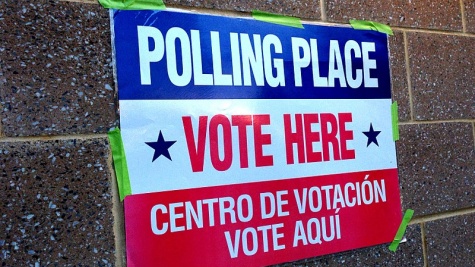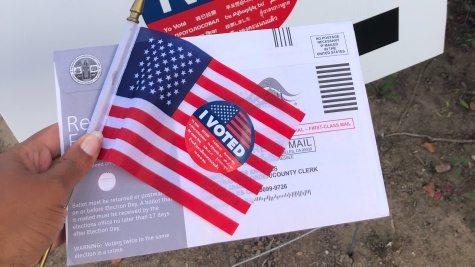How Do Local Election Officials Reach New Voters?
The MIT Election Data and Science Lab helps highlight new research and interesting ideas in election science, and is a proud co-sponsor of the Election Sciences, Reform, & Administration Conference (ESRA).
Our post today was written by Mara Suttman-Lea and Thessalia Merivaki, based on their paper presented at the 2021 ESRA Conference. The information and opinions expressed in this column represent their own research, and do not necessarily represent the opinions of the MIT Election Lab or MIT.
The 2020 United States Presidential Election featured a slew of changes to voting options in response to the COVID-19.
This, combined with a rising tide of mis-/disinformation about the election highlighted the vital role voter education and outreach from trusted sources plays American elections. On the front lines of providing this information to voters are local election officials (LEOs) — the nearly 8,000 officials in charge of administering elections in the United States.
LEOs have a range of tools they can use to engage in voter education and outreach. They can interact with voters in-person in their office, at community events, when they visit local high schools or colleges, or when they train third-party groups to register voters. They can also post ads in local newspapers or send informational mail to voters, and on TV and radio stations. Lastly, the accessibility and convenience of social media allows LEOs to cast a wider net to reach voters on a low cost and more regular basis.
How effective are these tools in reaching voters? Our research assesses these dynamics in the state of Florida, focusing specifically on whether they are effective at maintaining and expanding the pool of registered voters. We examine the effects voter education and outreach activities by Florida County Supervisors of Elections (SoEs) between 2014 and 2018 on new voter registrations, as well as how SoE use of social media during the 2020 Presidential election affected new registrations. We also explore the relationship between social media outreach and Floridian’s usage of Online Voter Registration, a tool which allows voters to register to vote and update their information online. We expect that social media played a significant role in encouraging voters to utilize OVR, because the COVID-19 pandemic created significant challenges for voter registration outreach both from LEOs, as well as third-party organizations, who are otherwise highly active in Florida.
Assessing the Impact of Face-to-Face, Traditional, and Social Media Voter Education Outreach on Voter Registration
We use an original data set that captures social media use by every local election official in the state of Florida with an active Facebook account combined with data from Florida’s Voter Education and Outreach Survey, a state-mandated survey administered to all 67 counties each federal election year. We argue that counties where SoEs engaged in more voter education and outreach efforts will have higher rates of new registrations. Research consistently shows that voters rely on local election officials for this information, and often they are not aware of the various options to register and vote in their state. SoEs are, therefore, a trusted source of information and can reduce these informational barriers.
In Florida, voter registration outreach can take many forms. The table below highlights the voter education activities used by SoEs, the most common of which were outreach to high schools, general face to face events held for the public, ads in newspapers and magazines and mailings to voters. When evaluating the impact of these activities on new voter registrations, controlling for electoral and factors and the partisanship of the LEO, we find that between 2014 and 2018, newspaper ads have a positive relationship with the rates of new registrations, as well as training of third-party organizations who conduct voter registration drives (see Figure 1, below).
Table: Variation Across FL’s 67 Counties on Face-to-Face Voter Registration Outreach
|
Counties with least compliance (responded no activity) |
2014 |
2016 |
2018 |
|
Community Colleges & Universities |
20 (29.8%) |
18 (26.8) |
17 (25.4%) |
|
Churches |
23 (34.3%) |
17 (25.4%) |
28 (41.8%) |
|
High Schools |
1*(1.5%) |
2**(3%) |
2**(3%) |
|
Events |
8 (12%) |
6 (9%) |
5 (7.4%) |
|
Libraries |
23 (34.3%) |
25 (37.3%) |
21(31.3%) |
|
Immigration Centers |
34 (50.7%) |
39 (58.2%) |
42 (62.7%) |
|
SoE Office |
8 (12% |
10 (15%) |
9 (13.4%) |
|
Third-Party Voter Registration Organizations |
26 (38.8%) |
23 (34.3%) |
23 (34.3%) |
|
Minority Communities |
19 (28.4%) |
13 (19.4%) |
16 (23.9%) |
Question: “Did your County participate in Voter Education Activities for the given Topic and Category?”
*(Franklin, Union); ** Franklin, Union, Columbia

Figure 1. Predictive Margins for Proportion of New Voter Registrations by method of outreach, 2014-2018.
Surprisingly, the presence of an active Facebook account has a negative relationship with the rate of new registrations. While our data cannot parse out the explanation for this surprising finding, it is possible that how an SoE used social media matters more for explaining the relationship between social media use and voter registration. Our monthly analysis of new voter registrations and use of online voter registration in 2020 offers some insight into this question, suggesting that the frequency of posting shapes the effects of social media use on registrations. As Figure 2 shows, OVR usage dramatically increased during the Presidential Primary month, and more so in the three months leading to the November election. These peaks in OVR applications seem to follow peaks in SoE Facebook post frequency, suggesting a potential relationship.

Figure 2. Rates of New Registrations, OVR Usage and Facebook Posts by Month in Florida, 2020.
While we find that the frequency of Facebook posts does not have a statistically significant relationship with new registration rates, our analysis of OVR use confirms the descriptive evidence from Figure 2. In jurisdictions where SoEs posted more regularly on their Facebook account, the rates of OVR applications increased. When we analyzed aggregate voter registration reports on how many of these applications were submitted by new voters and how many were updates to existing voters’ information, we found that the latter accounted for a higher proportion of OVR applications submitted during this period. This suggests that OVR was instrumental when SoEs were communicating with voters through social media, as they could direct prospective voters to OVR through their posts.
Social media can be a powerful, and low-cost tool for voter education
Overall, our analysis of voter education and outreach activities in Florida suggest that LEOs can have an impact on voter registrations through traditional—and potentially low-cost—activities such as newspaper ads. These findings also suggest that third-party groups like non-profit organizations may be more effective at expanding the registered electorate, which confirms existing research on the work of these groups in reaching under-represented voters, who are less likely to be registered.
While use of social media may not drive new registrations, it can be an important resource for LEOs to encourage voters to register and update their voter information when faced with limited opportunities for in-person voter outreach during the COVID-19 pandemic. As Florida County SoEs disclosed in the Voter Education surveys, Facebook was the most common platform used to promote important deadlines, voting processes and other election related information. These responses uncover important dynamics in how SoEs manage their social media accounts. For instance, in 2018, DeSoto County reported that they have “no time to monitor social media.” Madison County reported that they have office staff manage their social media accounts, and Miami-Dade reported that they paid for advertisements in English and Spanish across various social media platforms. These responses underscore the notable variation in resources and capacity across local jurisdictions, which may also explain the breadth and robustness of voter education outreach.
These findings open new avenues for research to understand the mechanism through which voter education can expand access to voting. In 2020, mail voting was the method of choice for many voters; an important question to explore is how LEOs used social media to inform voters about requesting and casting their mail ballots. Additionally, assessments of voter education and outreach raise further questions about how LEOs combat mis/disinformation on social media platforms and elsewhere. Last, but not least, there are significant differences in how social media are used by voters of different demographics. It is important to study, therefore, how LEOs use different platforms to reach new voters, particularly the youth, who view voting as important, but not necessarily exciting or convenient.




